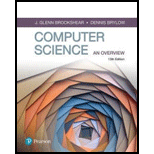
Explanation of Solution
Copyright laws:
“Yes”, a person who develops a new and useful
There are copyright laws which protect such act. Copyright laws protect the original creation of the owner. It protects the intellectual property of the owner or the result of creation from duplication.
Copyright is the legal right that owners have over their original creation, a right to save the original work of creation. It means that only genuine creator has right to give authorization to reproduce his original work. In this manner, such rights can be protected.
The extent up to which a language is owned is such that the copyright laws protect the expression of an idea but do not protect the idea itself...
Want to see the full answer?
Check out a sample textbook solution
Chapter 6 Solutions
Computer Science: An Overview (13th Edition) (What's New in Computer Science)
- Utilizing a programming language as a tool to solve problems is standard practice in the field of computer science. In what sense is it possible to define a "general-purpose programming language"?arrow_forwardIs there any evidence to support the concept of a single programming language for all applications?arrow_forwardWhen should a highly typed language be used for software development, and when should a weakly typed language be used instead?arrow_forward
- In what circumstances is it considered suitable to develop software using a weakly typed programming language as opposed to a strongly typed one? In what circumstances is it considered suitable to develop software using a weakly typed programming language as opposed to a strongly typed one?arrow_forwardWhy should we spend effort learning new languages? To what extent should programming languages be abstracted? What do you hope to accomplish? Could you please explain your thinking?arrow_forwardWhere does one even begin when it comes to studying different programming languages? Which level of a programming language is considered to be the most effective? Why does this seem to be the case? Could you perhaps elaborate on what you mean?arrow_forward
- To what end should we study so many computer languages? Where do you recommend the suitable programming languages be placed? Why bother? If you don't mind me asking, could you please explain your thinking?arrow_forwardIn what ways is it advantageous for a programmer who already has knowledge of a wide variety of programming languages to possess the ability to acquire more?arrow_forward
 C++ for Engineers and ScientistsComputer ScienceISBN:9781133187844Author:Bronson, Gary J.Publisher:Course Technology Ptr
C++ for Engineers and ScientistsComputer ScienceISBN:9781133187844Author:Bronson, Gary J.Publisher:Course Technology Ptr Fundamentals of Information SystemsComputer ScienceISBN:9781305082168Author:Ralph Stair, George ReynoldsPublisher:Cengage Learning
Fundamentals of Information SystemsComputer ScienceISBN:9781305082168Author:Ralph Stair, George ReynoldsPublisher:Cengage Learning Principles of Information Systems (MindTap Course...Computer ScienceISBN:9781285867168Author:Ralph Stair, George ReynoldsPublisher:Cengage Learning
Principles of Information Systems (MindTap Course...Computer ScienceISBN:9781285867168Author:Ralph Stair, George ReynoldsPublisher:Cengage Learning Systems ArchitectureComputer ScienceISBN:9781305080195Author:Stephen D. BurdPublisher:Cengage Learning
Systems ArchitectureComputer ScienceISBN:9781305080195Author:Stephen D. BurdPublisher:Cengage Learning



